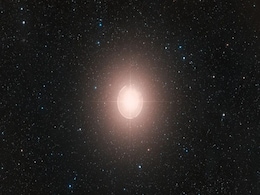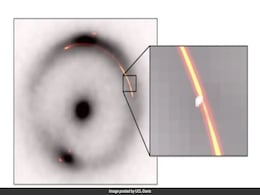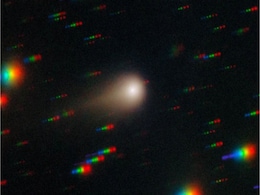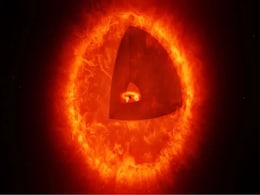Astronomical Objects
- All
- News
-

ISRO Captures Rare Close-Up Of Fast-Moving 3I/ATLAS. See Pic
- Thursday November 20, 2025
- Science | Edited by Amit Chaturvedi
As space agencies track the comet's path, 3I/ATLAS is offering astronomers rare clues about what lies beyond our Solar System.
-
 www.ndtv.com
www.ndtv.com
-

NASA To Release New Photos Of Interstellar Object 3I/ATLAS
- Wednesday November 19, 2025
- World News | Reuters
NASA is set on Wednesday to release new images of an interstellar object called 3I/ATLAS that astronomers have determined is a comet probably even older than our solar system.
-
 www.ndtv.com
www.ndtv.com
-

Could Interstellar Visitor 3I/ATLAS Be More Than A Comet? What Harvard Astronomer Said
- Tuesday November 18, 2025
- India News | Edited by NDTV News Desk
As the interstellar object 3I/ATLAS speeds through the solar system, Harvard astronomer Avi Loeb is keeping the possibility of it not being an ordinary comet alive.
-
 www.ndtv.com
www.ndtv.com
-

Comet Similar To Interstellar Object 3I/ATLAS Fast Moving Towards Earth
- Wednesday November 12, 2025
- Science | Edited by NDTV News Desk
Astronomers have observed a mysterious comet racing through the solar system towards both Earth and the Sun. It has led to comparisons with the famous interstellar object 3I/ATLAS.
-
 www.ndtv.com
www.ndtv.com
-

Astronomers Stunned As Rogue Planet Grows At Record Speed
- Monday November 3, 2025
- Science | Edited by Astitva Raj
The object, known as Cha 1107-7626, lies about 620 light-years away and is estimated to be five to ten times the mass of Jupiter.
-
 www.ndtv.com
www.ndtv.com
-

'Halloween Fireballs' Could Threaten Earth In 2032 And 2036, Astronomers Warn
- Sunday November 2, 2025
- Science | Edited by Astitva Raj
Recent research indicates that larger objects in the Taurid stream could pose a greater threat in 2032 and 2036, potentially exploding in the atmosphere or occasionally reaching the Earth's surface.
-
 www.ndtv.com
www.ndtv.com
-

NASA Telescopes Capture First-Ever Companion Star Orbiting Massive Red Supergiant Betelgeuse
- Sunday October 26, 2025
- Written by Gadgets 360 Staff
Astronomers have detected a small companion star orbiting the red supergiant Betelgeuse using Hubble and Chandra observations. Dubbed “Betelbuddy,” the discovery reveals an extreme binary system that challenges existing models of stellar evolution and may offer clues to Betelgeuse’s future.
-
 www.gadgets360.com
www.gadgets360.com
-

Astronomers Detect Hints Of Hidden Earth-Sized Planet Beyond Neptune
- Wednesday October 15, 2025
- Written by Gadgets 360 Staff
Astronomers propose the existence of ‘Planet Y’, a hidden Earth-size planet that may orbit closer than the theorized ‘Planet Nine’. Based on Kuiper Belt object patterns, the study suggests a rocky world influencing orbital tilts. Experts remain divided, but upcoming sky surveys could soon confirm or rule out its existence.
-
 www.gadgets360.com
www.gadgets360.com
-

Astronomers Spot Mysterious Dark Object In Distant Universe, It's A Million Times Larger Than The Sun
- Tuesday October 14, 2025
- Science | Edited by Ritu Singh
A mysterious object with a mass equivalent to 1 million suns has been detected in space, but its nature remains unknown.
-
 www.ndtv.com
www.ndtv.com
-

Mars and Jupiter Probes Set to Monitor Interstellar Comet 3I/ATLAS During Its Sun Approach This Month
- Saturday October 4, 2025
- Written by Gadgets 360 Staff
The European Space Agency (ESA) is keeping a close eye on the Interstellar Comet 3I/ATLAS on its journey through the solar system. A spacecraft, specially designed for the Jupiter and Mars missions, will monitor the interstellar comet. Notably, this is the third known interstellar object that has marked its way through the solar system and is conti...
-
 www.gadgets360.com
www.gadgets360.com
-

NASA’s James Webb Telescope May Have Found First Black Hole Star, Known as ‘The Cliff’
- Thursday September 25, 2025
- Written by Gadgets 360 Staff
JWST detected “The Cliff,” a candidate black hole star with a black hole core wrapped in a luminous gas shell. This discovery offers insights into black hole formation, stellar evolution, and cosmic dynamics, prompting astronomers to search for similar objects across the universe.
-
 www.gadgets360.com
www.gadgets360.com
-

JWST Identifies Compact, Metal-Poor Star-Forming Region Tracing Back to Early Universe
- Wednesday September 17, 2025
- Written by Gadgets 360 Staff
Astronomers using JWST have discovered LAP2, a tiny star-forming complex magnified by Abell 2744. With extremely low metallicity and a size under 33 light years, it provides rare insight into conditions resembling the early universe, offering clues about how the first stars formed and enriched galaxies with heavier elements
-
 www.gadgets360.com
www.gadgets360.com
-

New 'Quasi-Moon' Discovered in Earth Orbit May Have Been Hiding There for Decades
- Sunday September 14, 2025
- Written by Gadgets 360 Staff
Astronomers have identified asteroid 2025 PN7 as a possible quasi-moon of Earth, trailing our planet for nearly 70 years. At just 62 feet wide, it is the smallest and least stable quasi-satellite detected so far. Researchers believe advanced observatories like the Vera Rubin Observatory could uncover more hidden companions in Earth-like orbits
-
 www.gadgets360.com
www.gadgets360.com
-

Astronomers Discover Rogue Black Hole Racing Through a Distant Dwarf Galaxy
- Sunday September 14, 2025
- Written by Gadgets 360 Staff
Astronomers have discovered a rogue intermediate-mass black hole speeding through a dwarf galaxy 230 million light-years away. Unlike typical galactic centres, this displaced object is accreting material and blasting out jets, suggesting black holes can grow “offsite”. The finding offers rare evidence of elusive intermediate black holes and may...
-
 www.gadgets360.com
www.gadgets360.com
-

Light Pollution Threatens Global Observatories, Jeopardising Deep-Sky Astronomy
- Wednesday August 13, 2025
- Written by Gadgets 360 Staff
Light pollution is brightening skies over observatories at an alarming rate, with artificial light growing by up to 10% each year. Astronomers caution that this glow, intensified by widespread LED use and urban expansion, is threatening the ability of telescopes to detect faint cosmic objects and diminishing humanity’s shared right to experience ...
-
 www.gadgets360.com
www.gadgets360.com
-

ISRO Captures Rare Close-Up Of Fast-Moving 3I/ATLAS. See Pic
- Thursday November 20, 2025
- Science | Edited by Amit Chaturvedi
As space agencies track the comet's path, 3I/ATLAS is offering astronomers rare clues about what lies beyond our Solar System.
-
 www.ndtv.com
www.ndtv.com
-

NASA To Release New Photos Of Interstellar Object 3I/ATLAS
- Wednesday November 19, 2025
- World News | Reuters
NASA is set on Wednesday to release new images of an interstellar object called 3I/ATLAS that astronomers have determined is a comet probably even older than our solar system.
-
 www.ndtv.com
www.ndtv.com
-

Could Interstellar Visitor 3I/ATLAS Be More Than A Comet? What Harvard Astronomer Said
- Tuesday November 18, 2025
- India News | Edited by NDTV News Desk
As the interstellar object 3I/ATLAS speeds through the solar system, Harvard astronomer Avi Loeb is keeping the possibility of it not being an ordinary comet alive.
-
 www.ndtv.com
www.ndtv.com
-

Comet Similar To Interstellar Object 3I/ATLAS Fast Moving Towards Earth
- Wednesday November 12, 2025
- Science | Edited by NDTV News Desk
Astronomers have observed a mysterious comet racing through the solar system towards both Earth and the Sun. It has led to comparisons with the famous interstellar object 3I/ATLAS.
-
 www.ndtv.com
www.ndtv.com
-

Astronomers Stunned As Rogue Planet Grows At Record Speed
- Monday November 3, 2025
- Science | Edited by Astitva Raj
The object, known as Cha 1107-7626, lies about 620 light-years away and is estimated to be five to ten times the mass of Jupiter.
-
 www.ndtv.com
www.ndtv.com
-

'Halloween Fireballs' Could Threaten Earth In 2032 And 2036, Astronomers Warn
- Sunday November 2, 2025
- Science | Edited by Astitva Raj
Recent research indicates that larger objects in the Taurid stream could pose a greater threat in 2032 and 2036, potentially exploding in the atmosphere or occasionally reaching the Earth's surface.
-
 www.ndtv.com
www.ndtv.com
-

NASA Telescopes Capture First-Ever Companion Star Orbiting Massive Red Supergiant Betelgeuse
- Sunday October 26, 2025
- Written by Gadgets 360 Staff
Astronomers have detected a small companion star orbiting the red supergiant Betelgeuse using Hubble and Chandra observations. Dubbed “Betelbuddy,” the discovery reveals an extreme binary system that challenges existing models of stellar evolution and may offer clues to Betelgeuse’s future.
-
 www.gadgets360.com
www.gadgets360.com
-

Astronomers Detect Hints Of Hidden Earth-Sized Planet Beyond Neptune
- Wednesday October 15, 2025
- Written by Gadgets 360 Staff
Astronomers propose the existence of ‘Planet Y’, a hidden Earth-size planet that may orbit closer than the theorized ‘Planet Nine’. Based on Kuiper Belt object patterns, the study suggests a rocky world influencing orbital tilts. Experts remain divided, but upcoming sky surveys could soon confirm or rule out its existence.
-
 www.gadgets360.com
www.gadgets360.com
-

Astronomers Spot Mysterious Dark Object In Distant Universe, It's A Million Times Larger Than The Sun
- Tuesday October 14, 2025
- Science | Edited by Ritu Singh
A mysterious object with a mass equivalent to 1 million suns has been detected in space, but its nature remains unknown.
-
 www.ndtv.com
www.ndtv.com
-

Mars and Jupiter Probes Set to Monitor Interstellar Comet 3I/ATLAS During Its Sun Approach This Month
- Saturday October 4, 2025
- Written by Gadgets 360 Staff
The European Space Agency (ESA) is keeping a close eye on the Interstellar Comet 3I/ATLAS on its journey through the solar system. A spacecraft, specially designed for the Jupiter and Mars missions, will monitor the interstellar comet. Notably, this is the third known interstellar object that has marked its way through the solar system and is conti...
-
 www.gadgets360.com
www.gadgets360.com
-

NASA’s James Webb Telescope May Have Found First Black Hole Star, Known as ‘The Cliff’
- Thursday September 25, 2025
- Written by Gadgets 360 Staff
JWST detected “The Cliff,” a candidate black hole star with a black hole core wrapped in a luminous gas shell. This discovery offers insights into black hole formation, stellar evolution, and cosmic dynamics, prompting astronomers to search for similar objects across the universe.
-
 www.gadgets360.com
www.gadgets360.com
-

JWST Identifies Compact, Metal-Poor Star-Forming Region Tracing Back to Early Universe
- Wednesday September 17, 2025
- Written by Gadgets 360 Staff
Astronomers using JWST have discovered LAP2, a tiny star-forming complex magnified by Abell 2744. With extremely low metallicity and a size under 33 light years, it provides rare insight into conditions resembling the early universe, offering clues about how the first stars formed and enriched galaxies with heavier elements
-
 www.gadgets360.com
www.gadgets360.com
-

New 'Quasi-Moon' Discovered in Earth Orbit May Have Been Hiding There for Decades
- Sunday September 14, 2025
- Written by Gadgets 360 Staff
Astronomers have identified asteroid 2025 PN7 as a possible quasi-moon of Earth, trailing our planet for nearly 70 years. At just 62 feet wide, it is the smallest and least stable quasi-satellite detected so far. Researchers believe advanced observatories like the Vera Rubin Observatory could uncover more hidden companions in Earth-like orbits
-
 www.gadgets360.com
www.gadgets360.com
-

Astronomers Discover Rogue Black Hole Racing Through a Distant Dwarf Galaxy
- Sunday September 14, 2025
- Written by Gadgets 360 Staff
Astronomers have discovered a rogue intermediate-mass black hole speeding through a dwarf galaxy 230 million light-years away. Unlike typical galactic centres, this displaced object is accreting material and blasting out jets, suggesting black holes can grow “offsite”. The finding offers rare evidence of elusive intermediate black holes and may...
-
 www.gadgets360.com
www.gadgets360.com
-

Light Pollution Threatens Global Observatories, Jeopardising Deep-Sky Astronomy
- Wednesday August 13, 2025
- Written by Gadgets 360 Staff
Light pollution is brightening skies over observatories at an alarming rate, with artificial light growing by up to 10% each year. Astronomers caution that this glow, intensified by widespread LED use and urban expansion, is threatening the ability of telescopes to detect faint cosmic objects and diminishing humanity’s shared right to experience ...
-
 www.gadgets360.com
www.gadgets360.com
















